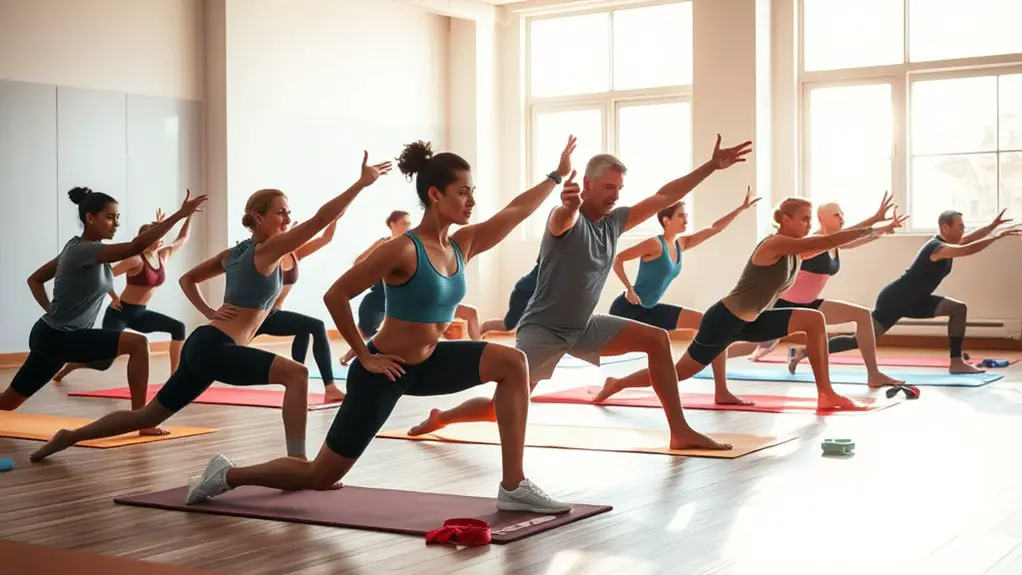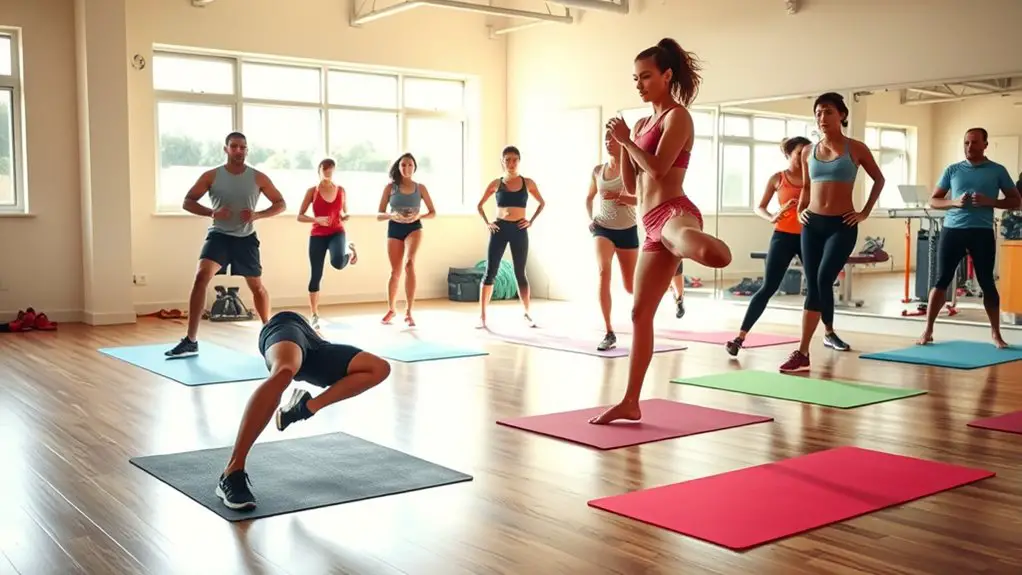The Benefits of Mobility Training for Injury Prevention

Mobility training reduces your risk of injuries by enhancing joint stability and flexibility, allowing for smoother movement patterns. Improved range of motion prevents stiffness and promotes efficient muscle coordination, which aids in injury avoidance. Incorporating dynamic and static stretching into your routine helps your body recover faster and reduces discomfort post-exercise. You’ll find that better posture and alignment further minimize strain on your muscles and joints. There’s plenty more to explore on how mobility training can support your fitness journey.
Understanding Mobility Training

While many people associate mobility training solely with flexibility, it encompasses a broader range of movement patterns that are vital for overall physical health. Mobility training focuses on improving your joint function and enhancing your body’s ability to move efficiently. One effective method is dynamic stretching, which prepares your muscles and joints for activity by promoting blood flow and increasing range of motion. It’s not just about getting loose; it’s about activating the right muscles to support movement patterns.
Incorporating foam rolling into your routine can further enhance mobility by breaking down muscle adhesions and improving tissue quality. This self-myofascial release technique helps alleviate tightness, allowing for smoother movement. By integrating both dynamic stretching and foam rolling into your mobility training regimen, you can reduce the risk of injury and optimize your physical performance. Remember, mobility isn’t just a warm-up; it’s a vital component of your overall fitness strategy.
Enhancing Flexibility and Range of Motion
To improve your overall movement quality, enhancing flexibility and range of motion is key. By focusing on effective mobility training, you can reduce your injury risk and boost performance. Here are some strategies you can incorporate:
- Dynamic Stretching: Start your workouts with dynamic stretches to warm up your muscles and joints, increasing blood flow and flexibility.
- Static Stretching: After your workout, use static stretching to improve overall flexibility and help your muscles recover. Hold each stretch for 15-30 seconds.
- Consistent Practice: Make flexibility training a regular part of your routine for long-term benefits. Aim for at least 2-3 times per week.
- Listen to Your Body: Pay attention to your limits and avoid pushing too hard. Gradual improvements lead to sustainable results.
Improving Joint Stability and Function

Improving joint stability and function is essential for maintaining an active lifestyle and preventing injuries. When you enhance joint stability, you support your body’s ability to perform functional movements effectively, reducing the risk of strains or sprains.
| Aspect | Description |
|---|---|
| Joint Stability | The ability of a joint to maintain its position during movement. |
| Functional Movement | Movements that mimic everyday activities, promoting overall strength. |
| Benefits | Increases mobility, enhances performance, and prevents injuries. |
| Training Methods | Exercises focusing on balance, strength, and control. |
| Examples | Squats, lunges, and stability ball exercises. |
Incorporating mobility training into your routine can greatly improve your joint stability and functional movement. This not only enhances your overall performance but also guarantees that you can stay active without the fear of injury. Prioritizing joint stability will help you enjoy a more resilient and capable body.
Promoting Better Posture and Alignment
Good posture and proper alignment are essential for preventing injuries and optimizing your movement efficiency. By focusing on postural alignment, you can enhance your spinal health and overall well-being. Here are some key benefits of improving your posture:
- Reduced Strain: Good alignment minimizes unnecessary stress on your muscles and joints, leading to less discomfort.
- Enhanced Performance: Proper posture allows for more efficient movement, which can boost your physical performance in daily activities and workouts.
- Improved Breathing: With better alignment, your diaphragm can function effectively, promoting deeper and more efficient breathing.
- Increased Confidence: Standing tall and aligned can positively impact your self-esteem and how others perceive you.
Incorporating mobility training into your routine helps develop the flexibility and strength needed for maintaining good posture, ensuring that you protect your body while enhancing your physical capabilities.
Reducing the Risk of Injuries

While injuries can happen to anyone, implementing effective mobility training can greatly reduce your risk. By enhancing your injury awareness, you become more attuned to your body’s signals and limitations, allowing you to identify potential issues before they escalate. Through focused mobility exercises, you can improve your movement patterns, ensuring that your joints and muscles function at their best.
This not only aids in maintaining flexibility and strength but also promotes proper biomechanics during physical activities. When your movement patterns are efficient, the likelihood of strains, sprains, and overuse injuries decreases markedly.
Moreover, developing a routine that emphasizes mobility can help you build resilience against common injuries, especially in high-risk sports or activities. Remember, being proactive with your mobility can lead to better performance and a healthier lifestyle, allowing you to enjoy your favorite activities with confidence and peace of mind.
Supporting Recovery and Rehabilitation
Supporting your recovery and rehabilitation is essential for regaining ideal function after an injury. By focusing on enhanced range of motion and improved muscle coordination, you can facilitate faster recovery times and reduce the likelihood of future issues. Implementing targeted mobility training in your rehabilitation process not only aids recovery but also strengthens your body for the demands ahead.
Enhanced Range of Motion
Enhancing your range of motion is crucial for effective recovery and rehabilitation, especially after an injury. Improved mobility can help prevent future injuries and facilitate a smoother healing process. Here are some key benefits of enhanced range of motion:
- Increased Flexibility: Regular dynamic stretching prepares your muscles for movement, while static stretching helps lengthen them post-activity.
- Reduced Pain: Improved motion decreases stiffness, which can alleviate discomfort and pain during recovery.
- Better Circulation: Enhanced range promotes blood flow, delivering essential nutrients to injured tissues.
- Faster Recovery: By incorporating both dynamic and static stretching, you can expedite your rehabilitation process and get back to your routine more quickly.
Prioritizing your mobility training can make a significant difference in your recovery journey.
Improved Muscle Coordination
Improving muscle coordination is essential for effective recovery and rehabilitation after an injury. When you engage in mobility training, you’re not just enhancing flexibility; you’re also promoting peak muscle activation. This process helps your body learn to work more efficiently, reducing the risk of re-injury. Coordination drills are particularly beneficial, as they challenge your muscles to communicate better and respond to movements more fluidly. By integrating these drills into your recovery program, you’ll notice significant improvements in how your muscles work together during daily activities. This heightened coordination not only aids in rehabilitation but also builds a stronger foundation for preventing future injuries, ensuring you can return to your favorite activities with confidence and control.
Faster Recovery Times
Mobility training accelerates recovery times by promoting blood circulation and reducing muscle stiffness. By incorporating mobility exercises into your routine, you enhance your body’s ability to recover from injuries and improve overall performance. Here are some key benefits:
- Active Recovery: Engaging in mobility work helps keep your muscles active, preventing stiffness and encouraging healing.
- Injury Awareness: Increased flexibility and awareness of your body’s limits can help you avoid re-injuring yourself.
- Reduced Muscle Soreness: Improved circulation flushes out metabolic waste, leading to less soreness post-exercise.
- Enhanced Range of Motion: Greater mobility allows for better movement patterns, reducing the risk of future injuries.
Incorporating mobility training can greatly support your recovery and rehabilitation efforts, ensuring you bounce back stronger.
Boosting Athletic Performance
To boost your athletic performance, focusing on mobility training can greatly enhance your range of motion and improve movement efficiency. By incorporating targeted exercises, you can release your body’s potential, allowing for smoother, more effective movements. This not only helps you perform better but also reduces the risk of injury, keeping you in the game longer.
Enhanced Range of Motion
When athletes work on enhancing their range of motion, they release the potential for improved performance and reduced risk of injury. By incorporating mobility training, you can achieve significant benefits, such as:
- Dynamic Stretching: Engaging in dynamic stretching before workouts warms up your muscles, preparing them for intense activity.
- Injury Prevention: With increased flexibility, you lower the chances of strains or tears during high-impact movements.
- Improved Recovery: Active recovery sessions incorporating mobility exercises help your muscles repair efficiently after workouts.
- Enhanced Athletic Performance: A greater range of motion allows for more effective movement patterns, boosting your overall athletic output.
Prioritizing these aspects in your training can be a game-changer, ensuring you stay agile and resilient on your athletic journey.
Improved Movement Efficiency
Improving movement efficiency can drastically elevate your athletic performance, as it enables you to execute skills more fluidly and with less energy expenditure. By incorporating dynamic stretching into your routine, you prepare your muscles for functional movements, enhancing your overall coordination. This pre-activity engagement not only reduces the risk of injury but also optimizes how your body utilizes energy during performance. When you move efficiently, each action becomes more purposeful, allowing you to maintain stamina over longer periods. You’ll find that your agility and speed improve, making it easier to adapt during competition. Ultimately, focusing on movement efficiency through mobility training can help you reach your peak performance while minimizing fatigue and enhancing your athletic abilities.
Incorporating Mobility Training Into Your Routine

Although you may have a busy schedule, incorporating mobility training into your routine is essential for enhancing flexibility and preventing injuries. Here’s how you can seamlessly integrate mobility drills and stretching techniques into your day:
Incorporating mobility training into your busy schedule is vital for improving flexibility and injury prevention.
- Morning Routine: Start your day with a quick 5-10 minute session of dynamic stretching to wake up your muscles and joints.
- Pre-Workout: Incorporate mobility drills focused on the areas you’ll be training, such as hip openers before leg day or shoulder mobility before upper body workouts.
- Breaks During the Day: Set a timer to remind you to take short breaks for mobility exercises, especially if you sit for long periods.
- Cool Down: Finish your workouts with static stretching techniques to enhance recovery and maintain flexibility.
Frequently Asked Questions
How Often Should I Perform Mobility Training Exercises?
How often should you perform mobility training exercises? Think of mobility as the oil that keeps your joints running smoothly. Ideally, you should incorporate these exercises into your daily routine, aiming for at least 10-15 minutes, 3-5 times a week. This exercise frequency guarantees your body stays flexible and resilient. Remember, consistency is key; even short sessions can make a significant difference in your overall mobility and performance.
Can Mobility Training Replace Traditional Strength Training?
Mobility training can’t entirely replace traditional strength training; they serve different purposes. While mobility training enhances your range of motion and flexibility, strength training builds muscle and power. Incorporating both into your routine can optimize performance and prevent injuries. If you focus solely on mobility, you might miss out on strength gains essential for overall fitness. It’s best to balance both to achieve thorough physical health and functional capability.
Is Mobility Training Suitable for All Age Groups?
Did you know that around 80% of people experience back pain at some point in their lives? Mobility training’s not just for athletes; it’s suitable for all age groups. It offers significant mobility benefits, enhancing flexibility and strength while catering to individual needs. However, age considerations matter—older adults may need gentler approaches. Regardless of your age, incorporating mobility training can improve your overall function and quality of life, making it a valuable practice for everyone.
What Equipment Do I Need for Mobility Training?
For effective mobility training, you don’t need much equipment. A foam roller is essential for self-myofascial release, helping to alleviate muscle tightness. Resistance bands are also valuable, allowing you to perform a variety of stretches and exercises that enhance flexibility and strength. With just these two tools, you can create a thorough mobility routine that fits your needs, making it easier to maintain your range of motion and overall physical health.
How Long Does It Take to See Results From Mobility Training?
When you start mobility training, it typically takes about 4 to 6 weeks to see noticeable results, depending on your training frequency and individual factors. Progress indicators, like increased range of motion and reduced stiffness, can help measure your advancement. Consistency is key, so aim for regular sessions—ideally several times a week. Remember, everyone’s journey is unique, and being patient with yourself will lead to sustainable improvements in your mobility over time.





